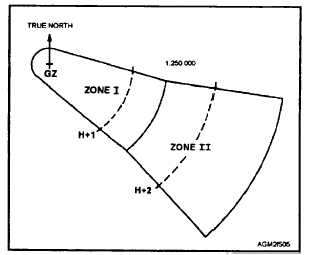NAV NBC 3 NUC
A. 24
D. 201405Z
F. 5600N 01115E
N. 10 KT
Y. 01000140 DEGREES
Z. 01000804
NBC 3 NUC
A. 24
D. 201405Z
F. 32VLB 126456
N. 10 KT
Y. GRID 17782489 MILS
Z. 01901508
Description of Elements
A. Strike serial number.
D. Date-time of strike.
F.
Coordinates of blast.
N. Weapon yield.
Y. Clockwise direction of left
fallout radial (4 digits), then the
right fallout radial (4 digits).
Z. Effective downwind speed (3
digits), Zone 1 downwind distance
(3 digits), and the cloud radius (2
digits).
N N N N
N N N N
NOTE: When the wind speed is less than 8 KPH (5 knots), the Zone I downwind distance in element 'Z' will be
reported in only 3 digits, which is the radius of the Zone I hazard from GZ.
Figure 5-4.—Example of the contents of NATO reports NAV NBC 3 NUC and NBC 3 NUC effective downwind messages.
also contains evaluated information on the detonation,
of time. Contaminated areas will remain radioactive for
including weapon yield, effective fallout direction and
a considerable period of time on land, but the
speed, and cloud radius.
contamination is dispersed rapidly over water areas.
An NBC 3 NUC message of effective fallout
downwind speed and direction for ground forces is
called an Effective Downwind Message. In this
message, locations are given in UTM coordinates,
angular measurements in degrees or mils, distances in
kilometers, and speeds in kilometers per hour. See
figure 5-4.
PLOTTING RADIOLOGICAL FALLOUT
AREAS
In the ATP-45, nuclear fallout is grouped into three
categories:
The quantity of fallout released by a blast is directly
proportional to the size of the blast—a low-yield blast
produces less fallout than a high-yield blast, and by the
height of the blast. A high-air burst produces very little
fallout, a low air-burst produces some fallout, and a
surface-burst produces great amounts of fallout. At sea,
a subsurface burst produces less fallout as the depth
increases, with negligible fallout if the fireball does not
break the surface. The effects of a nuclear blast are
discussed in detail in your Basic Military Requirements
course, as well as in Military Requirements for Petty
Officer Third Class.
Immediate fallout—heavy debris deposited near
ground zero within 1/2 hour of the blast.
Medium Range fallout—debris deposited from
1/2 hour to 20 hours after a blast, up to hundreds of
miles from g-round zero.
Figure 5-5 Shows a typical NATO fallout plot. The
+ marks the point where the weapon will be or has been
detonated, identified by the letters GZ for ground zero.
Long Range fallout-very light particles that
remain suspended in the atmosphere from 20
hours to several years. Fallout is deposited over
a very large area of the earth’s surface.
The NATO Nuclear fallout warning areas
discussed in this chapter show only the areas that
receive immediate and medium range fallout. The
hazard to people in contaminated areas depends on the
concentration of fallout, the amount of time the person
has been in the contaminated area, and the total
radiation the person has been exposed to over a period
Figure 5-5.—NATO fallout plot.
5-5


